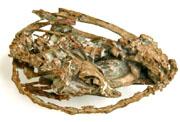 Mei long probably looked distinctly birdlike when catching forty winks.© Am. Mus. Nat. Hist.
Mei long probably looked distinctly birdlike when catching forty winks.© Am. Mus. Nat. Hist.The angst-ridden Prince Hamlet described death as an eternal sleep, fearfully wondering what dreams may come during the everlasting slumber. So perhaps he would have empathized with a dinosaur newly unearthed in China: it seems to have been preserved in the act of sleeping.
The dinosaur, named Mei long, or 'soundly sleeping dragon', has lain undisturbed for almost 140 million years. But its sleeping posture is strikingly similar to that of modern birds, showing that this position might have evolved before they did.
“You're seeing a snapshot of something that happened millions of years ago.”
Mark Norell
American Museum of Natural History, New York
M. long seems to have died with its hindlimbs folded underneath it and its head tucked under one forelimb, just as birds roost with their head under their wing. It is the oldest known fossil found in this posture, say its discoverers, Xing Xu of the Chinese Academy of Sciences in Beijing and Mark Norell of the American Museum of Natural History, New York, in Nature this week1.
The fact that M. long seems to have a sleeping habit that is so similar to that of modern birds means that the two probably share a common ancestor not much older than the dinosaur itself, the authors add.
Life study
It is rare for a fossil to be preserved in a 'life pose', which can tell us about an animal's behaviour as well as its body. "You're seeing a snapshot of something that happened millions of years ago," says Norell. "People who have seen the specimen have been blown away by it."
Fossils that tell us about day-to-day dinosaur life are incredibly valuable, agrees David Varricchio of Montana State University in Bozeman. Last month he unveiled an entire fossilized dinosaur family, demonstrating parental care in these animals (see ""Fossil hints at devoted parenting in dinosaurs":http://www.nature.com/news/2004/040906/full/040906-9.html").
'Death poses' are a lot more common than life poses, Varricchio says. Remains are often contorted by rigor mortis before they are buried and fossilized, he says.
 The fossil's posture gives clues to its behaviour as well as its body.© Am. Mus. Nat. Hist.
The fossil's posture gives clues to its behaviour as well as its body.© Am. Mus. Nat. Hist.M. long was probably buried alive quickly as a result of an eruption, Norell speculates. It was found in volcanic sediments in the province of Liaoning in northeast China. "There's lots of ash in the sediments," he says. "But it also could have been poisoned by noxious gas such as carbon monoxide. It's hard to show."
Hot stuff
The specimen's birdlike-posture also hints that the animal could have been warm-blooded, Norell says. Modern birds tuck their heads under one wing to conserve heat; perhaps M. long did the same.
“This is a really cool fossil, one of the neatest I've worked on.”
Mark Norell
American Museum of Natural History, New York
"Warm-bloodedness had to arise someplace," Norell says. "You can't directly take a fossil's temperature, but it is very closely related to modern birds."
This closeness is underlined by the dragon's diminutive size. At just 53 centimetres long, the dinosaur supports the theory that the evolution of flight in birds was helped by the fact that, as a family, they were fairly tiny.
The many theories surrounding M. long serve to underline Liaoning's status as perhaps the world's richest treasure trove of fossil dinosaurs. And Norell should know... he has seen plenty. "I think this is a really cool fossil," he enthuses, "one of the neatest I've worked on."
American Museum of Natural History, New York
American Museum of Natural History, New York
